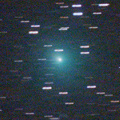
|
Now it is very bright as 6.6 mag (Nov. 11, Chris Wyatt). It will approach to Earth down to 0.08 a.u. in December, and it is expected to brighten up to 3 mag. In the Northern Hemisphere, it locates low until November, but it stays observable in excellent condition after December. In the Southern Hemisphere, it is observable in good condition until mid December when it brightens up to 3 mag. But it becomes unobservable after that.
Date(TT) R.A. (2000) Decl. Delta r Elong. m1 Best Time(A, h)
Nov. 17 2 7.78 -30 54.4 0.189 1.112 126 6.2 22:22 (180, 86)
Nov. 24 2 17.23 -27 5.1 0.154 1.086 126 5.4 22:05 (180, 82)
|
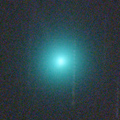
|
New bright comet discovered by three amateur comet hunters. Now it is 8.9 mag (Nov. 16, Katsumi Yoshimoto). It brightened rapidly from 10 mag up to 8 mag just after the discovery. But after that, the brightness evolution became slow. In the Northern Hemisphere, it is observable in the morning low sky until mid November. It can be observable in the extreme low sky until around Nov. 24. It can be observable in the extreme low sky in the evening at 5.5-7 mag from around Dec. 5 to around Dec. 15. In the Southern Hemisphere, it is not observable now. But it will appear in the morning sky at 14 mag in February, then it stays observable in good condition while the comet will be fading gradually.
Date(TT) R.A. (2000) Decl. Delta r Elong. m1 Best Time(A, h)
Nov. 17 13 20.56 -0 59.3 0.865 0.584 35 7.3 3:06 (275, -5)
Nov. 24 14 52.22 -0 57.8 0.691 0.465 25 5.9 3:00 (285,-19)
|
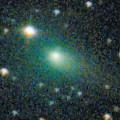
|
Now it is bright as 9.3 mag (Nov. 11, Marco Goiato). It stays 9-10 mag until January. In the Northern Hemisphere, it stays observable in good condition for a long time until it fades out. In the Southern Hemispehre, it is observable in good condition until autumn, but it will be low in winter.
Date(TT) R.A. (2000) Decl. Delta r Elong. m1 Best Time(A, h)
Nov. 17 7 44.47 23 27.5 0.841 1.590 120 9.2 3:06 (195, 30)
Nov. 24 7 57.50 25 55.6 0.811 1.597 124 9.1 3:00 (192, 28)
|
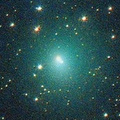
|
Now it is very bright as 9.0 mag (Nov. 16, Maik Meyer). It is observable in excellent condition in the Northern Hemisphere. It stays low in the Southern Hemisphere.
Date(TT) R.A. (2000) Decl. Delta r Elong. m1 Best Time(A, h)
Nov. 17 1 12.74 36 17.4 0.470 1.402 145 9.2 21:28 (180, 19)
Nov. 24 1 26.90 35 31.4 0.491 1.414 143 9.4 21:15 (180, 19)
|

|
It brightened up to 7.7 mag in June (June 19, Juan Jose Gonzalez). Now it is fading. But it is still bright as 10.7 mag (Nov. 11, Chris Wyatt). In the Southern Hemisphere, it stays observable in good condition for a long time until the comet will fade out. In the Northern Hemisphere, it is not observable for a long time until autumn in 2019 when the comet fades out down to 16 mag.
Date(TT) R.A. (2000) Decl. Delta r Elong. m1 Best Time(A, h)
Nov. 17 15 13.10 -72 39.8 2.934 2.483 53 10.8 3:06 (345, 24)
Nov. 24 15 26.25 -74 48.2 2.961 2.520 54 10.9 3:00 (346, 26)
|
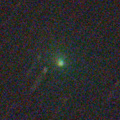
|
Now it is very bright as 10.8 mag (Oct. 12, Paul Camilleri). It stays at 10-11 mag until winter. In the Northern Hemisphere, it stays observable for a long time until it fades out. But it stays extremely low. It will never be observable again in the Southern Hemisphere.
Date(TT) R.A. (2000) Decl. Delta r Elong. m1 Best Time(A, h)
Nov. 17 16 55.34 5 26.5 2.474 1.724 32 10.9 20:23 ( 84,-18)
Nov. 24 17 11.81 7 11.5 2.455 1.715 33 10.8 20:33 ( 82,-23)
|

|
It brightened up to 6.8 mag in September (Sept. 17, Seiichi Yoshida). Now it is fading rapidly. It has already faded down to 11.1 mag (Nov. 11, Marco Goiato). It is observable in excellent condition in the Southern Hemisphere. It locates low after this in the Northern Hemisphere.
Date(TT) R.A. (2000) Decl. Delta r Elong. m1 Best Time(A, h)
Nov. 17 7 21.35 -35 25.8 0.768 1.377 102 11.6 3:06 (276, 83)
Nov. 24 7 15.40 -37 29.0 0.814 1.439 105 12.1 3:00 (338, 87)
|

|
Now it is 11.9 mag (Nov. 3, Seiichi Yoshida). It stays 12 mag for a long time until spring.
Date(TT) R.A. (2000) Decl. Delta r Elong. m1 Best Time(A, h)
Nov. 17 8 41.80 -3 17.8 2.623 2.956 99 12.2 3:06 (226, 49)
Nov. 24 8 33.55 -5 50.8 2.542 2.987 107 12.2 3:00 (218, 55)
|

|
Now it is 12.8 mag (Nov. 14, Sandor Szabo). It will be fading slowly after this. In the Northern Hemisphere, it will be getting higher gradually after this, and it will be observable in good condition. In the Southern Hemisphere, it is not observable until summer in 2019.
Date(TT) R.A. (2000) Decl. Delta r Elong. m1 Best Time(A, h)
Nov. 17 14 10.54 42 0.8 3.598 3.278 63 12.5 3:06 (240,-36)
Nov. 24 14 23.90 41 30.0 3.605 3.321 65 12.5 3:00 (240,-35)
|

|
Now it is 13.5 mag (Nov. 1, Paul Camilleri). It stays at 12-13 mag for a long time until autumn in 2019.
Date(TT) R.A. (2000) Decl. Delta r Elong. m1 Best Time(A, h)
Nov. 17 21 45.77 -8 45.9 2.046 2.293 91 13.4 20:23 (120, 48)
Nov. 24 21 54.13 -8 26.1 2.105 2.268 86 13.3 20:33 (114, 43)
|

|
Now it is bright as 12.9 mag (Nov. 11, Chris Wyatt). Diffuse.
Date(TT) R.A. (2000) Decl. Delta r Elong. m1 Best Time(A, h)
Nov. 17 22 44.99 -1 1.7 5.389 5.769 107 13.4 20:23 (146, 51)
Nov. 24 22 45.89 -1 0.1 5.497 5.769 101 13.4 20:33 (134, 46)
|

|
Now it is 13.8 mag (Nov. 1, Paul Camilleri). It will brighten up to 10-11 mag in autumn in 2019. It stays observable in good condition for a while in the Southern Hemisphere. In the Northern Hemisphere, it stays extremely low for a long time.
Date(TT) R.A. (2000) Decl. Delta r Elong. m1 Best Time(A, h)
Nov. 17 1 37.62 -44 21.7 4.124 4.587 111 13.7 21:51 ( 0, 81)
Nov. 24 1 29.41 -43 7.9 4.139 4.542 107 13.7 21:16 ( 0, 82)
|

|
Now it is 14.0 mag (Oct. 7, Seiichi Yoshida). It stays 13-14 mag until summer in 2019. It is not observable now in the Southern Hemisphere. It will be unobservable in November also in the Northeren Hemisphere.
Date(TT) R.A. (2000) Decl. Delta r Elong. m1 Best Time(A, h)
Nov. 17 16 41.00 -1 45.4 4.177 3.305 24 14.3 20:23 ( 75,-17)
Nov. 24 16 45.34 -3 15.7 4.198 3.294 20 14.3 20:33 ( 69,-22)
|

|
Now it is 14.0 mag (Nov. 3, Seiichi Yoshida). It stays at 14 mag until winter. It is observable in excellent condition in the Northern Hemisphere. In the Southern Hemisphere, it is not observable until summer in 2019.
Date(TT) R.A. (2000) Decl. Delta r Elong. m1 Best Time(A, h)
Nov. 17 10 12.20 74 49.9 1.450 1.959 105 14.3 3:06 (193,-25)
Nov. 24 10 55.57 75 51.2 1.448 1.968 106 14.3 3:00 (193,-26)
|

|
Now it is 13.5 mag (Nov. 14, Sandor Szabo). It will be observable at 13-14 mag for a long time from 2017 to 2018. It is observable in excellent condition until spring in the Northern Hemispehre. In the Southern Hemisphere, it will be hardly observable after this.
Date(TT) R.A. (2000) Decl. Delta r Elong. m1 Best Time(A, h)
Nov. 17 12 0.68 35 6.6 4.609 4.422 72 14.4 3:06 (235,-11)
Nov. 24 11 59.47 35 31.2 4.530 4.454 79 14.4 3:00 (232, -7)
|
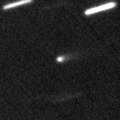
|
Now it is 14.8 mag (Nov. 10, Toshihiko Ikemura, Hirohisa Sato). Brightening very rapidly. It is observable at 14 mag in excellent condition until March.
Date(TT) R.A. (2000) Decl. Delta r Elong. m1 Best Time(A, h)
Nov. 17 9 54.19 10 59.1 1.354 1.640 87 14.7 3:06 (232, 27)
Nov. 24 10 10.00 9 9.9 1.296 1.632 90 14.5 3:00 (233, 29)
|

|
Now it is 15.4 mag (Oct. 7, iTelescope Observatory, Siding Spring). It locates low. But it brightens up to 14.5 mag from October to November.
Date(TT) R.A. (2000) Decl. Delta r Elong. m1 Best Time(A, h)
Nov. 17 18 59.07 -26 56.0 1.086 0.865 48 14.7 20:23 ( 74, 25)
Nov. 24 19 44.29 -26 4.5 1.057 0.900 52 15.1 20:33 ( 76, 27)
|
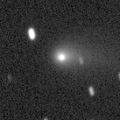
|
Now it is 13.9 mag (Nov. 8, Chris Wyatt). It will be fading after this. It stays observable in excellent condition for a while in the Southern Hemisphere. It locates somewhat low in the Northern Hemisphere.
Date(TT) R.A. (2000) Decl. Delta r Elong. m1 Best Time(A, h)
Nov. 17 23 0.23 -22 35.5 1.697 2.143 102 14.7 20:23 (126, 71)
Nov. 24 23 8.59 -21 12.7 1.789 2.162 98 15.0 20:33 (117, 65)
|
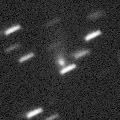
|
It brightened up to 8.7 mag in July (July 18, Marco Goiato). Then it faded down to 12.3 mag in August (Aug. 29, Chris Wyatt). Now it is not observable. It will appear in the morning sky in late December.
Date(TT) R.A. (2000) Decl. Delta r Elong. m1 Best Time(A, h)
Nov. 17 15 7.71 -24 18.1 3.139 2.162 7 14.8 3:06 (310,-11)
Nov. 24 15 18.12 -23 45.2 3.220 2.252 9 15.1 3:00 (308, -9)
|

|
Now it is 14.5 mag (Aug. 16, P. Camilleri, H. Williams). It stays 15 mag from 2018 to 2019, and it will be observable for a long time in the Southern Hemisphere. In the Northern Hemisphere, it will never be observable again.
Date(TT) R.A. (2000) Decl. Delta r Elong. m1 Best Time(A, h)
Nov. 17 17 0.45 -68 40.3 4.512 3.979 51 15.0 20:23 ( 23, 27)
Nov. 24 17 27.56 -68 33.6 4.529 3.969 50 15.0 20:33 ( 23, 26)
|

|
Now it is 16.5 mag (Oct. 4, I. Dulevich, S. Plaksa). It will brighten up to 13-14 mag in winter, and it will be observable in excellent condition. It locates low in the Southern Hemisphere.
Date(TT) R.A. (2000) Decl. Delta r Elong. m1 Best Time(A, h)
Nov. 17 10 19.70 27 45.4 2.022 2.218 87 15.3 3:06 (226, 10)
Nov. 24 10 32.11 27 32.2 1.935 2.203 91 15.1 3:00 (224, 12)
|
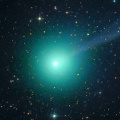
|
It brightened rapidly in outburst up to 6.9 mag (July 19, Maik Meyer). Then it faded down to 9.3 mag (Aug. 2, Katsumi Yoshimoto). It approached to Sun down to 0.2 a.u. in August, and it was expected to brighten up to 3 mag. However, it must have been already disintegrated. In the Northern Hemisphere, it is appearing in the morning sky. But it will be too faint to observe.
Date(TT) R.A. (2000) Decl. Delta r Elong. m1 Best Time(A, h)
Nov. 17 13 24.91 24 17.3 2.518 2.070 52 15.2 3:06 (254,-21)
Nov. 24 13 33.46 25 55.8 2.537 2.181 57 15.4 3:00 (251,-19)
|

|
It must have brightened up to 13 mag in October. But it is not observable at all.
Date(TT) R.A. (2000) Decl. Delta r Elong. m1 Best Time(A, h)
Nov. 17 16 29.71 -12 6.9 2.154 1.237 16 15.2 20:23 ( 66,-12)
Nov. 24 16 56.55 -12 1.8 2.197 1.282 16 16.4 20:33 ( 64,-14)
|

|
It approached to Earth down to 0.3 a.u., and brightened up to 8.3 mag in July (July 22, Juan Jose Gonzalez). Now it is fading. It has faded down to 13.2 mag in September (Sept. 24, Thomas Lehmann). Now it is not observable. It will appear in the morning sky again in December in the Northern Hemisphere, or in January in the Southern Hemisphere.
Date(TT) R.A. (2000) Decl. Delta r Elong. m1 Best Time(A, h)
Nov. 17 15 20.63 -5 13.9 2.962 2.015 13 15.4 3:06 (299,-27)
Nov. 24 15 22.77 -4 51.1 3.006 2.087 17 15.6 3:00 (295,-23)
|
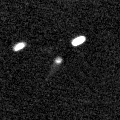
|
Now it is 15.8 mag (Oct. 13, S. Shurpakov). It will brighten up to 15 mag in winter. It is observable in excellent condition in the Northern Hemisphere. It is not observable at all in the Southern Hemisphere.
Date(TT) R.A. (2000) Decl. Delta r Elong. m1 Best Time(A, h)
Nov. 17 11 19.37 48 26.7 3.222 3.321 87 15.8 3:06 (219,-13)
Nov. 24 11 18.99 51 5.1 3.096 3.311 93 15.7 3:00 (215,-12)
|

|
Now it is 16.0 mag (Oct. 11, C. Bell). It is expected to brighten up to 7-8 mag in 2020. In 2018, it will be observable at 15-16 mag in good condition from autum to winter.
Date(TT) R.A. (2000) Decl. Delta r Elong. m1 Best Time(A, h)
Nov. 17 3 34.24 -6 2.4 5.133 6.044 155 15.9 23:48 (180, 61)
Nov. 24 3 29.47 -5 58.4 5.090 5.985 152 15.8 23:16 (180, 61)
|
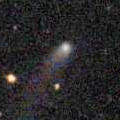
|
It brightened up to 14.7 mag in early 2018 (Jan. 25, Catalina Sky Survey). Now it is fading slowly. Now it is 16.6 mag (Nov. 15, Toshihiko Ikemura, Hirohisa Sato). In the Northern Hemisphere, it stays observable in good condition for a long time until the comet fades out. It is never observable again in the Southern Hemisphere.
Date(TT) R.A. (2000) Decl. Delta r Elong. m1 Best Time(A, h)
Nov. 17 8 10.61 65 14.4 5.463 5.950 115 16.5 3:06 (189,-11)
Nov. 24 8 2.05 66 46.9 5.419 5.973 119 16.5 3:00 (185,-12)
|
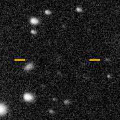
|
Now it is 17.4 mag (Nov. 14, Toshihiko Ikemura, Hirohisa Sato). It is observable at 16.5 mag in good condition from autumn to winter. But it is fainter than this ephemeris recently. It locates somewhat low in the Southern Hemisphere.
Date(TT) R.A. (2000) Decl. Delta r Elong. m1 Best Time(A, h)
Nov. 17 8 29.96 25 35.2 1.871 2.405 110 16.6 3:06 (205, 25)
Nov. 24 8 33.87 25 12.5 1.806 2.416 116 16.5 3:00 (201, 27)
|
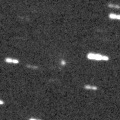
|
It stays 15 mag for a long time in 2019. In the Southern Hemisphere, it is observable in excellent condition. In the Northern Hemisphere, it is observable in low sky until early January, but it will be unobservable after that.
Date(TT) R.A. (2000) Decl. Delta r Elong. m1 Best Time(A, h)
Nov. 17 11 23.14 -25 45.4 4.114 3.663 56 16.7 3:06 (281, 31)
Nov. 24 11 25.93 -27 53.3 3.996 3.631 61 16.6 3:00 (281, 36)
|

|
Now it is 17.0 mag (Oct. 12, D. Buczynski). It stays 16-17 mag for a long time until 2020. It is observable in good condition in the Northern Hemisphere. It is not observable at all in the Southern Hemisphere.
Date(TT) R.A. (2000) Decl. Delta r Elong. m1 Best Time(A, h)
Nov. 17 11 29.20 68 36.3 8.285 8.467 97 16.7 3:06 (202,-26)
Nov. 24 11 35.86 68 58.0 8.225 8.464 100 16.7 3:00 (201,-25)
|

|
It brightened up to 7 mag from May to June in 2017. Now it is fading. It has already faded down to 16.0 mag (Sept. 30, J. Drummond). In the Southern Hemisphere, it stays observable for a long time after this. It will never be observable again in the Northern Hemisphere.
Date(TT) R.A. (2000) Decl. Delta r Elong. m1 Best Time(A, h)
Nov. 17 0 57.85 -52 17.4 5.655 5.936 101 16.7 21:12 ( 0, 73)
Nov. 24 0 54.71 -51 27.2 5.781 5.995 97 16.8 20:41 ( 0, 74)
|
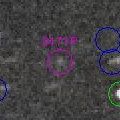
|
Now it is 17.2 mag (Nov. 14, Toshihiko Ikemura, Hirohisa Sato). It will brighten rapidly. It was expected to be observable at 15.5 mag in good condition in winter. But it is somewhat fainter than expected.
Date(TT) R.A. (2000) Decl. Delta r Elong. m1 Best Time(A, h)
Nov. 17 4 56.16 -6 40.5 0.942 1.848 146 17.0 1:14 (180, 62)
Nov. 24 4 51.45 -5 35.5 0.905 1.831 150 16.9 0:42 (180, 61)
|

|
Now it is 17.6 mag (Nov. 11, Toshihiko Ikemura, Hirohisa Sato). It is observable in good condition in the Southern Hemisphere. It locates somewhat low in the Northern Hemisphere.
Date(TT) R.A. (2000) Decl. Delta r Elong. m1 Best Time(A, h)
Nov. 17 22 50.31 -17 42.9 3.100 3.454 102 16.9 20:23 (130, 65)
Nov. 24 22 53.13 -17 1.7 3.215 3.469 96 17.0 20:33 (119, 59)
|
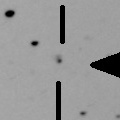
|
Asteroid, but it brightened rapidly. Now it is 16.4 mag (Oct. 9, P. Camilleri, J. Oey).
Date(TT) R.A. (2000) Decl. Delta r Elong. m1 Best Time(A, h)
Nov. 17 22 17.86 -44 19.5 6.732 6.727 85 17.0 20:23 ( 58, 67)
Nov. 24 22 14.46 -43 45.8 6.830 6.713 79 17.0 20:33 ( 62, 60)
|
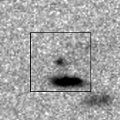
|
Now it is 17.5 mag (Oct. 10, D. Buczynski). It is observable at 17 mag in good condition in winter. It locates low in the Southern Hemisphere.
Date(TT) R.A. (2000) Decl. Delta r Elong. m1 Best Time(A, h)
Nov. 17 10 42.55 20 1.5 2.248 2.293 79 17.1 3:06 (235, 12)
Nov. 24 10 51.48 20 7.4 2.200 2.332 85 17.0 3:00 (233, 14)
|
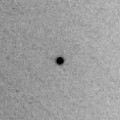
|
Now it is 16.2 mag (Sept. 13, ATLAS-MLO, Mauna Loa). It will be fading after this, and will be fainter than 18 mag in December. It is observable in good condition in the Northern Hemisphere. It is not observable in the Southern Hemisphere. Its cometary activity was observed on Mar. 26 (M. Mommert, D. Polishook, N. Moskovitz).
Date(TT) R.A. (2000) Decl. Delta r Elong. m1 Best Time(A, h)
Nov. 17 1 5.50 52 10.9 1.712 2.524 136 17.0 21:20 (180, 3)
Nov. 24 0 59.49 51 1.3 1.797 2.581 133 17.2 20:46 (180, 4)
|
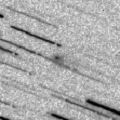
|
First return of a new periodic comet which brightened up to 17.5 mag in 2010. Now it is 17.2 mag (Nov. 14, Toshihiko Ikemura, Hirohisa Sato). It was expected to brighten up to 16.5 mag from November to December. But actually, it is a bit fainter than expected. It is observable in excellent condition in the Northern Hemisphere. It locates low in the Southern Hemisphere.
Date(TT) R.A. (2000) Decl. Delta r Elong. m1 Best Time(A, h)
Nov. 17 6 14.71 31 57.1 1.115 1.980 140 17.2 2:32 (180, 23)
Nov. 24 6 14.15 33 5.9 1.088 1.991 147 17.2 2:04 (180, 22)
|

|
Now it is 17.0 mag (Nov. 14, Toshihiko Ikemura, Hirohisa Sato). Fading slowly. It stays observable at 17 mag in good condition until summer in 2019.
Date(TT) R.A. (2000) Decl. Delta r Elong. m1 Best Time(A, h)
Nov. 17 11 33.58 5 45.2 10.268 9.854 62 17.2 3:06 (254, 12)
Nov. 24 11 35.81 5 42.1 10.170 9.863 69 17.2 3:00 (251, 16)
|
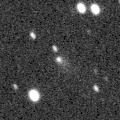
|
First return of a new periodic comet which brightened up to 16.5 mag in 2005. Now it is 17.3 mag (Nov. 15, Toshihiko Ikemura, Hirohisa Sato). It will be fading after this, and will be fainter than 18 mag in December. It locates low in the Southern Hemisphere.
Date(TT) R.A. (2000) Decl. Delta r Elong. m1 Best Time(A, h)
Nov. 17 1 48.29 28 2.2 1.214 2.153 155 17.3 22:03 (180, 27)
Nov. 24 1 48.90 26 27.3 1.260 2.172 150 17.4 21:36 (180, 29)
|

|
Now it is 17.4 mag (Nov. 10, Toshihiko Ikemura, Hirohisa Sato). It was observed at 17 mag in last winter. It will be observable in good condition at 17.5 mag also in this winter.
Date(TT) R.A. (2000) Decl. Delta r Elong. m1 Best Time(A, h)
Nov. 17 5 19.44 6 49.2 7.149 8.023 150 17.4 1:37 (180, 48)
Nov. 24 5 14.15 6 23.5 7.114 8.029 156 17.4 1:05 (180, 49)
|
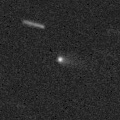
|
It brightened rapidly. Now it is 17.0 mag (Nov. 10, Toshihiko Ikemura, Hirohisa Sato). It will be fading after this, and will be fainter than 18 mag in December.
Date(TT) R.A. (2000) Decl. Delta r Elong. m1 Best Time(A, h)
Nov. 17 1 44.61 0 45.4 1.615 2.514 148 17.4 21:59 (180, 54)
Nov. 24 1 42.08 1 5.9 1.673 2.524 141 17.5 21:29 (180, 54)
|

|
Now it is 17.1 mag (Oct. 13, Alexander Baransky). It was observed at 18 mag in last winter. It will be observable in good condition at 17.5 mag also in this winter.
Date(TT) R.A. (2000) Decl. Delta r Elong. m1 Best Time(A, h)
Nov. 17 7 28.32 4 46.5 2.312 2.931 119 17.5 3:06 (195, 49)
Nov. 24 7 28.30 4 4.9 2.254 2.946 126 17.5 3:00 (187, 51)
|

|
Now it is 17.0 mag (Nov. 11, Toshihiko Ikemura, Hirohisa Sato). It will be fading gradually after this, and it will be fainter than 18 mag in winter. In the Northern Hemisphere, it stays observable in good condition for a long time. In the Southern Hemisphere, it will never be observable again.
Date(TT) R.A. (2000) Decl. Delta r Elong. m1 Best Time(A, h)
Nov. 17 22 40.74 71 20.1 7.400 7.849 113 17.5 20:23 (173,-18)
Nov. 24 22 44.16 70 22.7 7.436 7.876 113 17.5 20:33 (170,-18)
|
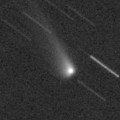
|
Now it is 17.0 mag (Oct. 12, ATLAS-MLO, Mauna Loa). Fading now. It stays observable in good condition for a long time after this in the Southern Hemisphere. It stays low in the Northern Hemisphere.
Date(TT) R.A. (2000) Decl. Delta r Elong. m1 Best Time(A, h)
Nov. 17 22 41.32 -39 53.0 4.952 5.071 91 17.5 20:23 ( 68, 72)
Nov. 24 22 37.91 -39 48.8 5.101 5.101 84 17.6 20:33 ( 70, 64)
|
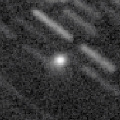
|
Now it is 18.0 mag (Nov. 10, Toshihiko Ikemura, Hirohisa Sato). It brightened up to 16 mag in 2018 spring. It stays observable in good condition until 2019 spring when the comet will be fainter than 18 mag.
Date(TT) R.A. (2000) Decl. Delta r Elong. m1 Best Time(A, h)
Nov. 17 10 44.95 3 20.0 3.598 3.441 72 17.5 3:06 (248, 23)
Nov. 24 10 48.90 4 7.5 3.527 3.482 79 17.5 3:00 (244, 26)
|

|
Now it is 18.1 mag (Oct. 15, Kunihiro Shima). Although it is around the aphelion, it is observable at 17.5 mag in November, in good condition in the Northern Hemisphere. It locates very low in the Southern Hemisphere.
Date(TT) R.A. (2000) Decl. Delta r Elong. m1 Best Time(A, h)
Nov. 17 2 46.77 38 14.0 1.428 2.377 158 17.5 23:00 (180, 17)
Nov. 24 2 29.35 36 28.5 1.433 2.365 155 17.6 22:15 (180, 19)
|

|
It brightened very rapidly. Now it is 17.0 mag (Nov. 10, Toshihiko Ikemura, Hirohisa Sato). It seems to stay bright for a while.
Date(TT) R.A. (2000) Decl. Delta r Elong. m1 Best Time(A, h)
Nov. 17 0 1.28 -9 16.8 1.054 1.786 121 17.6 20:23 (176, 64)
Nov. 24 0 7.01 -7 23.4 1.119 1.797 117 17.8 20:33 (160, 61)
|

|
Peculiar asteroid moving along a cometary orbit. Now it is 17.2 mag (Sept. 9, M. Jaeger, et al.). It is observable at 17.5 mag in good condition in November. It locates somewhat low in the Southern Hemisphere.
Date(TT) R.A. (2000) Decl. Delta r Elong. m1 Best Time(A, h)
Nov. 17 3 33.51 23 47.2 2.114 3.100 174 17.6 23:47 (180, 31)
Nov. 24 3 29.59 23 0.4 2.111 3.094 173 17.6 23:16 (180, 32)
|
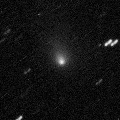
|
It brightened very rapidly up to 13.8 mag in August in 2017 (Aug. 22, Kunihiro Shima). Now it is 16.9 mag (Oct. 11, D. Buczynski). In the Northern Hemisphere, it stays observable in excellent condition after this. It stays extremely low in the Southern Hemisphere.
Date(TT) R.A. (2000) Decl. Delta r Elong. m1 Best Time(A, h)
Nov. 17 10 42.40 29 25.5 2.462 2.555 83 17.6 3:06 (228, 5)
Nov. 24 10 51.74 29 50.3 2.404 2.582 88 17.6 3:00 (226, 7)
|
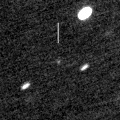
|
Now it is 17.2 mag (Nov. 14, Toshihiko Ikemura, Hirohisa Sato). It is observable at 17.5 mag until January, in good condition in the Northern Hemisphere. It locates very low in the Southern Hemisphere.
Date(TT) R.A. (2000) Decl. Delta r Elong. m1 Best Time(A, h)
Nov. 17 6 36.54 39 24.0 2.996 3.757 134 17.7 2:54 (180, 16)
Nov. 24 6 33.85 40 14.5 2.946 3.767 141 17.7 2:24 (180, 15)
|

|
Now it is 17.0 mag (Nov. 6, Toshihiko Ikemura, Hirohisa Sato). It will be fading after this. It will be fainter than 18 mag in December.
Date(TT) R.A. (2000) Decl. Delta r Elong. m1 Best Time(A, h)
Nov. 17 22 8.31 -6 25.2 1.553 1.946 97 17.7 20:23 (129, 50)
Nov. 24 22 19.71 -5 46.2 1.613 1.939 93 17.8 20:33 (123, 45)
|
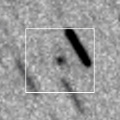
|
First return of a new periodic comet which brightened up to 16 mag in 2011. It must be brightening rapidly. It is observable at 17.5 mag in good condition in winter.
Date(TT) R.A. (2000) Decl. Delta r Elong. m1 Best Time(A, h)
Nov. 17 2 48.31 17 36.1 1.538 2.518 170 18.0 23:02 (180, 37)
Nov. 24 2 43.87 16 27.8 1.542 2.500 162 17.9 22:30 (180, 39)
|

|
Now it is 17.7 mag (Nov. 10, Toshihiko Ikemura, Hirohisa Sato). It will be fainter than 18 mag in December.
Date(TT) R.A. (2000) Decl. Delta r Elong. m1 Best Time(A, h)
Nov. 17 5 6.24 1 38.9 7.008 7.883 150 17.9 1:24 (180, 53)
Nov. 24 5 3.95 1 28.9 7.012 7.917 154 17.9 0:54 (180, 53)
|
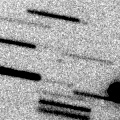
|
Now it is 18.8 mag (Oct. 8, A. Martin, K. Kleemann-Boeker). It is observable at 17 mag in good condition in winter in the Northern Hemisphere. It locates very low in the Southern Hemisphere.
Date(TT) R.A. (2000) Decl. Delta r Elong. m1 Best Time(A, h)
Nov. 17 9 9.08 30 24.2 0.921 1.499 103 18.1 3:06 (211, 17)
Nov. 24 9 31.10 31 0.5 0.883 1.492 105 17.9 3:00 (211, 16)
|

|
It was expected to be observable at 17.5 mag in good condition in winter in the Northern Hemisphere. But actually, it is so faint as 21.0 mag (Oct. 5, K. Sarneczky, et. al). It locates low in the Southern Hemisphere.
Date(TT) R.A. (2000) Decl. Delta r Elong. m1 Best Time(A, h)
Nov. 17 5 56.09 31 21.7 2.233 3.091 144 18.0 2:14 (180, 24)
Nov. 24 5 52.57 32 1.0 2.175 3.081 151 17.9 1:43 (180, 23)
|
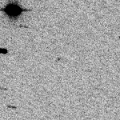
|
Return of a new periodic comet which brightened up to 17 mag in 2001. Now it is 19.2 mag (Oct. 12, K. Hills). It was predicted to brighten up to 17.5 mag from September to November. But actually, it is fainter than predicted by 2 mag.
Date(TT) R.A. (2000) Decl. Delta r Elong. m1 Best Time(A, h)
Nov. 17 1 27.94 -8 25.9 1.370 2.218 139 19.6 21:42 (180, 63)
Nov. 24 1 25.87 -6 54.2 1.427 2.228 133 19.7 21:13 (180, 62)
|
|
![]()
 C/2015 O1 ( PanSTARRS )
C/2015 O1 ( PanSTARRS ) 60P/Tsuchinshan 2
60P/Tsuchinshan 2 300P/Catalina
300P/Catalina 48P/Johnson
48P/Johnson C/2017 T3 ( ATLAS )
C/2017 T3 ( ATLAS ) C/2017 B3 ( LINEAR )
C/2017 B3 ( LINEAR ) 123P/West-Hartley
123P/West-Hartley C/2017 S3 ( PanSTARRS )
C/2017 S3 ( PanSTARRS ) 26P/Grigg-Skjellerup
26P/Grigg-Skjellerup C/2018 N1 ( NEOWISE )
C/2018 N1 ( NEOWISE ) C/2018 A3 ( ATLAS )
C/2018 A3 ( ATLAS ) C/2017 T2 ( PanSTARRS )
C/2017 T2 ( PanSTARRS ) C/2016 A1 ( PanSTARRS )
C/2016 A1 ( PanSTARRS ) 59P/Kearns-Kwee
59P/Kearns-Kwee C/2018 A6 ( Gibbs )
C/2018 A6 ( Gibbs ) C/2010 U3 ( Boattini )
C/2010 U3 ( Boattini ) C/2015 V2 ( Johnson )
C/2015 V2 ( Johnson ) 171P/Spahr
171P/Spahr 65P/Gunn
65P/Gunn A/2017 U7
A/2017 U7 164P/Christensen
164P/Christensen (3552) Don Quixote
(3552) Don Quixote 369P/2018 P1 ( Hill )
369P/2018 P1 ( Hill ) C/2014 B1 ( Schwartz )
C/2014 B1 ( Schwartz ) 368P/2018 L3 ( NEAT )
368P/2018 L3 ( NEAT ) C/2015 XY1 ( Lemmon )
C/2015 XY1 ( Lemmon ) 243P/NEAT
243P/NEAT 361P/2017 S4 ( Spacewatch )
361P/2017 S4 ( Spacewatch ) C/2014 OE4 ( PanSTARRS )
C/2014 OE4 ( PanSTARRS ) C/2015 V1 ( PanSTARRS )
C/2015 V1 ( PanSTARRS ) C/2018 E1 ( ATLAS )
C/2018 E1 ( ATLAS ) (3200) Phaethon
(3200) Phaethon P/2018 P3 ( PanSTARRS )
P/2018 P3 ( PanSTARRS ) (37117) Narcissus
(37117) Narcissus 240P/NEAT
240P/NEAT 159P/LONEOS
159P/LONEOS 137P/Shoemaker-Levy 2
137P/Shoemaker-Levy 2 373P/2018 R2 ( Rinner )
373P/2018 R2 ( Rinner ) C/2011 KP36 ( Spacewatch )
C/2011 KP36 ( Spacewatch ) 247P/LINEAR
247P/LINEAR 232P/Hill
232P/Hill 371P/2018 R1 ( LINEAR-Skiff )
371P/2018 R1 ( LINEAR-Skiff )![]()

















































